Exploring Palm Development in Ras Al Khaimah
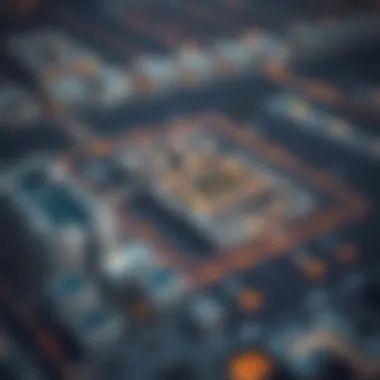
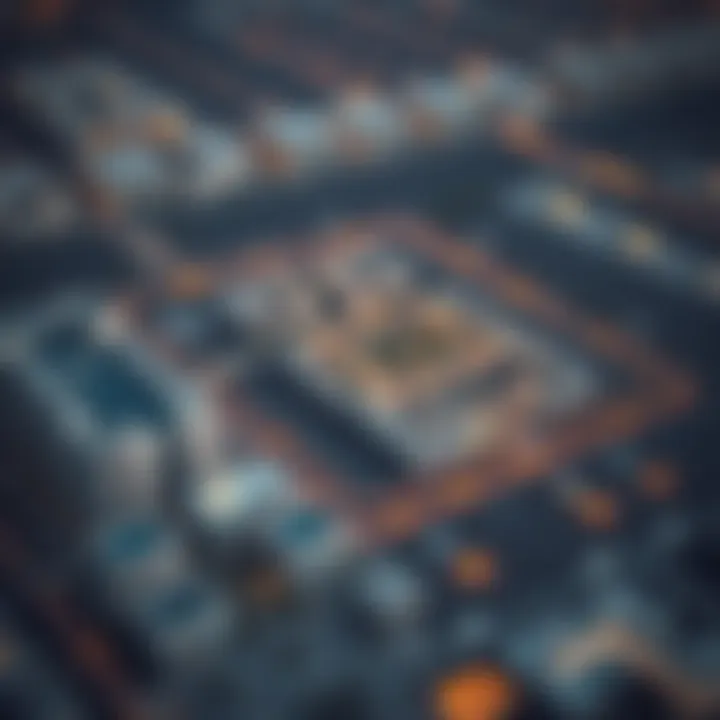
Intro
Ras Al Khaimah, one of the seven emirates of the United Arab Emirates, is quietly carving out its niche in the competitive world of real estate development. Among the most ambitious projects sprouting in this region is the Palm, a unique venture that aligns with the broader goals of economic and community growth. This article aims to unpack the layers of this development, highlighting its implications not just for investors and property managers, but also for the residents who will eventually call it home.
The aim is to dive into various aspects of the Palm project, specifically the planning processes, architectural considerations, and the economic and social ramifications associated with it. By shedding light on these factors, readers will gain valuable insights that could steer informed decisions in the evolving landscape of Ras Al Khaimah's real estate.
Market Insights
Current Trends in Ras Al Khaimah Real Estate
The real estate landscape in Ras Al Khaimah is rapidly changing, with rising interest from both local and international investors. Recent reports suggest a steady increase in property demand driven by favorable economic conditions and government incentives. One particular trend worth noting is the influx of luxury residential developments, drawing affluent buyers looking for a serene lifestyle that offers both opulence and tranquility.
Additionally, with ongoing infrastructural enhancements and improved accessibility to various amenities, community interest in real estate investments continues to grow. One can't overlook the increasing popularity of sustainable living practices in the region, with developers beginning to implement green spaces and eco-friendly technology in new projects, including the Palm.
Analysis of Investment Opportunities
Investors need to keep a sharp eye on this evolving landscape, as opportunities abound.
- Property Appreciation: Growing demand in Ras Al Khaimah has resulted in property values steadily rising, making it a lucrative investment zone.
- Government Support: The emirate has introduced several measures aimed at bolstering the real estate sector, such as reduced property fees and flexible payment plans.
- Diverse Offerings: The Palm project serves as a flagship example, showcasing a blend of residential, commercial, and recreational spaces designed to enhance community life and investment prospects.
"The real estate landscape in Ras Al Khaimah is becoming a blank canvas for innovative developments that blend luxury with sustainability."
Investors looking for a balance of risk and reward should certainly consider the Palm project. The potential for returns is reinforced by the emirate's strategic plan for economic diversification, poised to attract further foreign investment and interest.
Neighborhood Features
Spotlight on Popular Developments
Ras Al Khaimah is home to several exciting developments, but none has captured attention quite like the Palm. Expect unique architectural designs, luxury amenities, and a focus on community-building that is reflective of the emirate’s larger ambitions. Other developments, such as Al Hamra Village, showcase residential options that cater to various tastes, providing a backdrop that complements the luxurious lifestyle one can find at the Palm.
Comparison of Different Areas in Ras Al Khaimah
Understanding the neighborhoods surrounding the Palm is crucial for any serious buyer or investor:
- Al Hamra: Known for its golf courses and upscale living, perfect for those seeking leisure and luxury.
- Ras Al Khaimah City Center: An urban hub experiencing rapid development with a mixture of residential and commercial spaces, attracting a younger demographic.
These dynamics illustrate how different areas cater to varied lifestyles and investment goals, ultimately enriching the overall experience of living in Ras Al Khaimah.
In summary, the Palm Ras Al Khaimah project stands as a beacon of opportunity, making it essential for investors and stakeholders to grasp the numerous facets and potentials that come with this development.
Intro to Ras Al Khaimah’s Real Estate Landscape
Ras Al Khaimah, often referred to as RAK, is more than just an emirate in the United Arab Emirates; it’s a burgeoning real estate hub. The shifting sands of time have transformed RAK's landscape from a primarily rugged terrain to a vibrant urban environment, teeming with opportunities. Understanding its real estate landscape is critical not only for investors and property managers but also for home buyers looking to make informed decisions.
The real estate market in Ras Al Khaimah is a key player in the region's economic architecture. As developments like the Palm project unfold, the significance of understanding local dynamics cannot be overstated. Investors need to grasp the geographical, economic, and regulatory frameworks that influence property value and desirability.
Geographical and Economic Overview
Ras Al Khaimah is tucked away in the northern part of the UAE, bordered by a glorious coastline and the Hajar Mountains. This unique geography offers a diverse range of landscapes, making it an attractive destination for various developments. The emirate is characterized by its rich cultural heritage, scenic beauty, and strategic location—positioning it as a vital gateway to the Gulf and beyond.
Economically, the emirate is gradually shedding its dependence on oil revenues, focusing instead on tourism, manufacturing, and real estate. The impressive growth of the real estate sector has been a focal point for economic diversification. In 2021, RAK witnessed a surge in property transactions, which were reflective of investor confidence. This trend is underpinned by favorable government policies aimed at attracting foreign investments, enhancing the overall economic framework.
Significance of Real Estate in Economic Development
Real estate in Ras Al Khaimah is not merely about bricks and mortar; it serves as a crucial driver for economic development. The sector generates jobs, fosters innovation, and boosts tourism—all integral components for sustainable growth. As projects like the Palm development evolve, they bring in significant foreign direct investment while simultaneously creating numerous employment opportunities.
Key benefits of the real estate sector in economic terms include:
- Job Creation: Construction projects lead to the establishment of both skilled and unskilled employment.
- Increased Tax Revenues: A thriving real estate market boosts government revenues, which can be reinvested into local infrastructure and public services.
- Enhanced Infrastructure: Development often accompanies improvements in roads, utilities, and other amenities, enhancing overall living standards.
- Tourism Attraction: Iconic projects draw tourists and investors alike, further embedding RAK’s status as a forthcoming destination.
Understanding these elements is imperative for any stakeholder involved in the property market. As RAK continues to evolve, the interaction between real estate development and overall economic health will only intensify, making awareness of these dynamics an invaluable asset.
The Palm Project: An Overview
The Palm project stands at the forefront of real estate development in Ras Al Khaimah, carving a niche that resonates throughout the region. It's not merely about constructing buildings; it encapsulates a visionary approach to transforming the landscape, fostering economic opportunities, and promoting sustainable living. The significance of this project lies not only in its scale but also in its ambition to merge luxury with environmental consciousness, catering to upscale residents while respecting ecological frameworks.
Concept and Vision for the Development
At the heart of the Palm project is a carefully crafted vision aimed at establishing Ras Al Khaimah as a key player in the global luxury real estate market. The idea behind this development is to create a community that radiates sophistication and modernity, akin to other global hotspots.
- Integrated Living Spaces: The design philosophy champions integrated communities where residential, recreational, and commercial areas coexist harmoniously. This fosters a sense of neighborhood, crucial for community building.
- Luxury and Sustainability: Ensuring high standards of luxury while embedding sustainable practices forms the crux of the Palm project. Incorporating renewable energy sources and efficient waste management systems emphasizes a commitment to lower the ecological footprint.
- Market Positioning: To elevate its status, the Palm project aims to attract affluent buyers and investors globally. Its unique offerings, combined with strategic marketing initiatives, promise to transform the financial landscape of Ras Al Khaimah.
In essence, the concept is more than just bricks and mortar; it's about creating an experience that inspires and captivates potential residents and investors alike.
Architectural Highlights
The architectural vision for the Palm project seamlessly marries aesthetics with functionality, reflecting the cultural nuances of the region while embracing modern design elements.
- Iconic Structures: Each building is poised to become a landmark, standing as a testament to innovative architecture. The use of local materials, along with cutting-edge design principles, ensures these structures are not only visually striking but also structurally sound.
- Open Spaces and Green Areas: Landscaped parks and recreational facilities are interspersed within the development. This greenery aims for a positive impact on residents’ health and well-being, fostering outdoor activities in a serene environment.
- Cultural References: The design intricately weaves in aspects of local culture, which is evident in the use of traditional motifs and architectural styles. This respects the heritage of Ras Al Khaimah while serving contemporary needs.
"The architectural essence of the Palm project highlights a deliberate commitment to advancing unique designs that embody both luxury and local heritage."
In summary, the design and architecture of the Palm project not only aim for visual appeal but also command functionality and communal living, making it a cornerstone of Ras Al Khaimah’s real estate ambition.
Planning and Regulatory Framework
The planning and regulatory framework plays a crucial role in the development of the Palm Ras Al Khaimah project. It serves as the backbone that determines how land can be used, the design quality expected, and the environmental safeguards necessary for sustainable growth. Without a well-structured framework, the dreams of a promising real estate venture can quickly turn into a chaotic reality riddled with legal disputes, environmental crises, and community backlash.
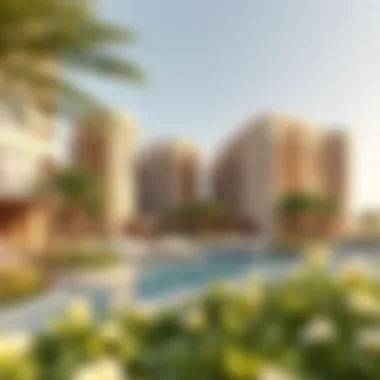

Zoning Regulations Affecting Development
Zoning regulations are the rules that dictate how land can be utilized in specific areas. For the Palm development, these regulations not only dictate what type of structures can be built but also influence the density, height, and aesthetic of any new construction.
Key Points of Zoning Regulations:
- Usage Classification: Different zones are designated for residential, commercial, and recreational purposes. This classification ensures that the Palm project integrates properly with existing urban and natural landscapes.
- Height Restrictions: To maintain a harmonious skyline and prevent overwhelming the local community, there are often limits on how tall buildings can be. This is particularly significant in a visually concentrated area like Ras Al Khaimah.
- Setback Requirements: Building setbacks are essential to guarantee that structures do not encroach on public spaces or neighboring properties. They help maintain the character of the neighbourhood and provide adequate access for utilities and emergency services.
The proper navigation and adherence to these rules are vital for attracting investors, ensuring that development aligns with vision, while also safeguarding local interests.
Environmental Impact Assessments
Before shovels hit the dirt, Environmental Impact Assessments (EIAs) are essential components of the planning processes for any large-scale development like the Palm project. EIAs evaluate the potential environmental consequences of a proposed project, providing a thorough analysis of how it might affect the surrounding area.
Why EIAs Matter:
- Mitigation Measures: Understanding potential impacts allows developers to incorporate strategies that minimize harm. This can include measures such as controlling runoff, preserving native vegetation, and integrating renewable energy sources.
- Community Involvement: The assessment process frequently involves public consultations, offering local residents a voice in the planning stages. This inclusion helps in building trust between developers and the community.
- Legal Compliance: Regulatory bodies require EIAs to comply with environmental laws. When developers ensure adherence to these guidelines, it can streamline the administrative process and forestall potential legal issues down the line.
As more emphasis is placed on sustainable development, the rigorous execution of EIAs is not simply a bureaucratic step—it’s foundational for respecting both environmental and social dynamics.
"A successful development doesn’t just sprout; it evolves with considerate planning and respect for surroundings."
In summary, the planning and regulatory framework, characterized by zoning regulations and environmental assessments, secures the integrity of the Palm Ras Al Khaimah development. By putting these frameworks into practice, stakeholders can move forward on investment opportunities, ensuring a responsible and profitable development, while being attuned to both the environment and local communities.
For more information on regulations affecting property development, you can visit Wikipedia on Zoning or review guidelines from the UAE Ministry of Climate Change and Environment.
This focusing on diversely integrating community needs and legal frameworks will have an impact beyond mere numbers on a balance sheet—it will shape the essence of Ras Al Khaimah for years to come.
Economic Implications of Palm Development
The development of the Palm in Ras Al Khaimah is more than just a construction project; it represents a significant pivot in the region's economic narrative. The infusion of capital, infrastructure enhancement, and the resulting job creation paint a picture of growth that extends beyond mere bricks and mortar. The potential benefits from this development can ripple through the economy, sharpening the competitive edge of Ras Al Khaimah on the global real estate stage.
Investment Opportunities and Risks
In a world where every penny counts, understanding where to invest becomes paramount. The Palm project is a goldmine of investment opportunities. From luxury villas to commercial spaces, there's something for every flavor of investor. However, one must also go into this venture with their eyes wide open. Risks are a constant companion in any development, and here they can be particularly multifaceted.
- High Demand: With the increase in tourism and expatriate populations in Ras Al Khaimah, the demand for premium properties has surged. Investors can expect lucrative returns if they plan wisely.
- Regulatory Environment: While the local government is keen on promoting development, the regulatory framework can sometimes throw a spanner in the works. Staying abreast of zoning laws and environmental regulations is crucial.
- Market Volatility: Real estate isn’t always a sure bet. Economic shifts, both local and global, can affect investment stability. Investors should conduct thorough market research before committing.
Quote for consideration:
“An investment in knowledge pays the best interest.” - Benjamin Franklin
By balancing potential gains with careful risk assessment, investors can make well-informed decisions, positioning themselves advantageously in the fast-evolving real estate market of Ras Al Khaimah.
Projected Economic Impact on the Region
The projections surrounding the economic impact of the Palm development are notably optimistic. It is anticipated that this venture will lead to a surge in local employment, an uptick in tourism rates, and a greater influx of foreign investment. The Palm project aims to serve as more than just a residential area; it will act as a catalyst for broader economic progress.
- Job Creation: Thousands of job opportunities are expected to stem from this development, not only during the construction phase but also in long-term operations. This will enhance the local job market significantly.
- Tourism Boost: With luxury amenities and leisure options like waterfront activities and parks, the Palm will attract tourists from around the globe, contributing further to the local economy.
- Local Business Growth: As new residents move in and tourists flock to the area, local businesses, such as restaurants and retail shops, will benefit from increased foot traffic and consumer spending.
Aesthetic and Environmental Considerations
The development of Palm Ras Al Khaimah is not just about constructing buildings; it is about weaving a narrative of beauty and sustainability into the very fabric of the region. This endeavor highlights the interplay of aesthetics and environmental consciousness, which becomes vital in shaping a project that is as visually appealing as it is ecologically responsible.
This section delves into the significance of aesthetic and environmental considerations, focusing on how thoughtful design and sustainable practices can transform the landscape while preserving its natural charm. Investors and stakeholders must realize that today's consumers are not just seeking homes; they desire a lifestyle that resonates with their values, including a commitment to environmental stewardship.
Sustainable Development Practices
Sustainable development practices play a pivotal role in the planning and execution of real estate projects. In the case of Palm Ras Al Khaimah, the goal is to create a harmonious balance between human activity and nature. Utilizing renewable energy sources, such as solar power, is one of the cornerstones of sustainable development here. With an abundance of sunlight in the region, harnessing this energy is both a practical and necessary choice.
Moreover, water conservation technologies and recycling initiatives are being incorporated into the project. For instance, rainwater harvesting systems can significantly reduce dependency on external water sources.
- Key sustainable practices include:
- Use of eco-friendly building materials.
- Designed landscapes that minimize ecological footprint.
- Effective waste management systems.
These practices not only contribute to a lower environmental impact but also enhance the overall aesthetic appeal, ensuring that the development is in tune with its surroundings. When potential buyers see that a property is built with an eye toward sustainability, they may be more inclined to invest.
Integration with Local Flora and Fauna
Integrating local flora and fauna into the Palm development is critical in nurturing biodiversity while providing lush surroundings for residents. Instead of opting for exotic plants that require extensive maintenance and water, the use of native species promotes a sense of place and encourages wildlife to thrive.
Incorporating green spaces, such as parks and community gardens, fosters a sense of community and offers habitats for local wildlife. Not only do these elements provide aesthetic benefits, but they also contribute to the mental well-being of residents.
“Respecting and enhancing the natural landscape is essential. It creates a living environment that resonates with the heritage of the area.”
The symbiosis between architecture and environment fosters a unique identity for Palm Ras Al Khaimah—one that values ecological balance as much as it does luxury living. In essence, the careful consideration given to aesthetic and environmental aspects ensures that this development is not merely an addition to the skyline, but rather, it becomes an integral part of Ras Al Khaimah's rich tapestry.
By prioritizing aesthetic and environmental considerations, investors not only secure financial returns but also contribute to a legacy that aligns with the increasing demand for responsible living solutions.
Marketing Strategies for Palm Properties
Crafting a precise and effective marketing strategy for Palm properties in Ras Al Khaimah is crucial in today’s competitive market. With an intricate blend of local charm and global aspirations, the marketing efforts must resonate authenticity while appealing to various investor segments. The real estate field here isn’t just about selling properties; it’s about weaving a narrative that reflects the unique qualities of the region and the Palm project itself.
In this context, understanding the strategic elements of marketing is vital not only for attracting buyers but also for creating lasting impressions that can lead to referrals and return investments. Insights into buyer psychology, local culture, and international trends are some of the essential considerations that can shape promotional tactics.
Target Audience Identification
Identifying the right audience is the bedrock of any successful marketing strategy. For Palm properties, the target audience ranges from international investors looking for property diversification to local families seeking a serene. This diverse demographic requires a nuanced approach in marketing communications.
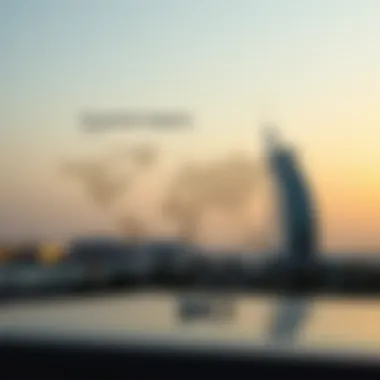

- High-Net-Worth Individuals: These clients are often seeking luxury and exclusivity. Highlighting unique features, bespoke services, and lifestyle benefits will capture their attention.
- Expat Community: Given the international nature of Ras Al Khaimah, many expatriates are potential buyers. Marketing should emphasize the community aspect and how Palm fits into their lifestyle needs.
- Eco-Conscious Buyers: With a growing emphasis on sustainability, showcasing the environmentally friendly aspects of Palm properties can attract buyers who prioritize green living.
Understanding these segments allows for tailored messaging and targeted channels, making marketing efforts more effective.
Branding the Palm Experience
Creating a strong brand identity for Palm properties is as crucial as the properties themselves. The brand needs to convey aspiration, safety, and belonging while ensuring it differentiates from other developments in the region.
- Visual Identity: A unique logo, color palette, and marketing materials can create an immediate connection with the brand. Visually appealing imagery highlighting the lush landscapes, architectural elegance, and vibrant community events fosters a sense of desire.
- Storytelling: Weaving narratives about the development process, community engagement, and future aspirations can strike a chord with potential homeowners and investors alike. For instance, explaining the inspiration behind the Palm could resonate deeply with those valuing authenticity.
- Experience-Centric Marketing: Instead of merely listing property features, demonstrating how it feels to live in these homes—through virtual tours, engaging lifestyle blogs, or testimonials from current residents—can draw prospective buyers in.
A strong brand identity enhances market presence and builds trust, ultimately leading to better customer relationships and sales performance.
Overall, the marketing strategies employed should capitalize on the distinctiveness of the Palm project while addressing the diverse needs and preferences of potential buyers. By doing so, it not only cultivates a robust market presence but also nurtures the long-term viability of Palm properties in Ras Al Khaimah.
Community Engagement and Local Impact
The development of the Palm in Ras Al Khaimah is not just about building luxury homes or commercial spaces; it touches upon the very fabric of the community. Engaging local stakeholders and addressing their concerns is pivotal to the project's success. The idea isn’t merely to construct a vibrant new area but to ensure that the local populace feels an intrinsic connection to it. This inclusion fosters a sense of ownership and pride amongst residents, making the Palm not just a development but a part of Ras Al Khaimah’s heart.
Involving Local Stakeholders
Involving local stakeholders is crucial in any large-scale development. For the Palm project, this means initiating dialogues with residents, local businesses, and government entities early in the planning process. By doing so, developers can gauge the community's needs and aspirations. This can lead to a few undeniable benefits:
- Transparency: Open communication helps preempt concerns and build trust. For instance, if potential environmental impacts are discussed openly, misunderstandings can be minimized.
- Tailored Solutions: Local input helps in creating spaces that reflect the culture and lifestyle of the community. If residents express a need for parks, playgrounds, or communal areas, planners can adjust accordingly.
- Support for Small Businesses: Engaging local entrepreneurs will likely create an economy that thrives on neighborhood establishments. This can also create job opportunities for locals, thus increasing economic independence.
Finding common ground may require patience and effort, but the payoff is immeasurable. A collective approach not only reduces the chances of potential backlash but can also lead to innovative ideas that surprise even seasoned developers.
Cultural Integration and Respect for Heritage
In any development project, particularly in a culturally rich region like Ras Al Khaimah, it is imperative to prioritize cultural integration and respect for heritage. The Palm should not stand apart from the community; instead, it should enhance and celebrate local traditions and history. Here are a few key considerations:
- Architectural Style: Incorporating elements of traditional Emirati architecture into new buildings can create a bridge between the old and the new. It is essential that the design doesn’t overshadow the local identity. Elements like wind towers and intricate geometric patterns can be included to maintain this connection.
- Community Events: Hosting cultural events on site can foster a sense of belonging and celebration. From local crafts and exhibitions to traditional music events, the Palm can become a hub for cultural exchange.
- Education Programs: Involving schools and local museums could help educate future generations about their heritage. This not only promotes appreciation but cultivates local pride.
Communities thrive when their unique stories and backgrounds are honored rather than simply overshadowed by modern development. The challenge lies in striking a balance between creating something new while being deeply rooted in local culture.
"A community that remembers its past while embracing the future is one that will flourish."
Overall, the importance of community engagement and cultural integration cannot be understated. The success of the Palm is intimately tied to how well the project resonates with the hearts and minds of the people it serves. To put it plainly, the future of Ras Al Khaimah depends on communities feeling like they are an integral part of the journey, not just witnesses to it.
For more insights on community engagement in property developments, consider exploring the resources available at Wikipedia and other educational platforms.
Technological Innovations in Development
The landscape of property development is transforming rapidly, and technological innovations are at the forefront of this evolution. In Ras Al Khaimah, particularly in the context of the Palm project, the integration of advanced technologies has not only enhanced the efficiency of development processes but also promised a brighter future for the residents and investors alike.
With smart infrastructure and connectivity becoming the backbone of modern urban spaces, the Palm Ras Al Khaimah is a significant case study. By leveraging cutting-edge technologies, developers are creating a seamless living experience that is both luxurious and sustainable. The implications of these innovations are broad, influencing everything from construction practices to day-to-day management of properties.
Smart Infrastructure and Connectivity
Smart infrastructure serves as the keystone in realizing the ambitious vision for Palm Ras Al Khaimah. The emphasis on interconnected systems ensures that various technological aspects work in harmony. Here’s a closer look at the core elements of this approach:
- IoT Integration: The Internet of Things (IoT) has heralded a new era in property management. Sensors embedded in buildings can monitor energy consumption, security status, and climate controls in real-time.
- Automated Systems: From smart thermostats to automated lighting, technology enables properties to adjust according to the preferences of the occupants. This not only enhances the comfort but also contributes to energy efficiency.
- High-Speed Connectivity: The inclusion of robust internet infrastructure facilitates seamless connectivity, essential for both residents and businesses. In today’s digital age, the ability to work from home or access services remotely is non-negotiable.
"Smart buildings are not just about advanced technology; they are about creating spaces that foster greater community interaction and sustainability."
Through these innovations, Palm Ras Al Khaimah ensures that future residents are equipped for a connected lifestyle, enhancing the overall living experience.
Future-Forward Residential Solutions
As the demand for innovative housing solutions grows, the Palm project is setting the stage for future-forward residential developments. New trends are emerging, heavily influenced by advancements in technology:
- Sustainable Building Materials: Emphasizing eco-friendly materials not only contributes to environmentally conscious living but also reduces overall construction costs in the long run.
- Modular Construction: Innovative construction techniques, such as modular and prefabrication, improve efficiency, allowing for quicker turnaround times without compromising quality.
- Smart Home Technologies: Features such as voice-activated assistants and remote monitoring redefine what it means to live comfortably. Residents of Palm can expect homes that recognize their needs and adjust functionalities accordingly.
In summary, the technological innovations integrated into the Palm Ras Al Khaimah reflect a commitment to creating an advanced and sustainable living environment. For investors and potential homeowners, understanding these aspects not only highlights the advantages of the development but also signals a shift towards a smarter future.
Challenges Facing Palm Development
The development of the Palm project in Ras Al Khaimah aims to not only redefine the local skyline but also to become a beacon of economic growth and sustainable living. However, like a double-edged sword, the path to achieving these lofty ambitions is fraught with challenges. Understanding these hurdles is crucial for investors, property managers, and prospective homeowners who are looking to stake their claim in this promising venture. Examining the market fluctuations and economic shifts, as well as environmental and regulatory challenges, offers a clearer picture of the landscape that surrounds the Palm initiative.
Market Fluctuations and Economic Shifts
Economic dynamics play a pivotal role in shaping the success of large-scale real estate projects. The real estate market, much like the tides, is constantly changing. Fluctuations in demand, alongside varying interest rates and currency values, can significantly affect property investments. Investors often find themselves navigating unpredictable waters; what may seem like a solid opportunity today could emerge as a financial pitfall tomorrow. In the context of Palm development, the impact of global economic trends must not be overlooked.
Consider, for instance, how broader economic downturns, such as recessions, allow very little room for extravagant property developments. A sudden drop in disposable incomes or a rise in unemployment can stall sales, leaving projects half-finished or, in some cases, entirely abandoned. Moreover, changes in government monetary policies can lead to fluctuations in the cost of borrowing, influencing prospective home buyers’ decisions.
Investors should also closely observe the demand for luxury versus affordable housing. Shifts in consumer preferences can indicate whether the market favors high-end villas or more budget-friendly residences. Those who stay attuned to these movements can position themselves advantageously within the market. In an environment like Ras Al Khaimah, where tourism plays a vital role in the economy, it is sensible to anticipate how fluctuations in visitor numbers, perhaps caused by geopolitical tensions or global health concerns, will translate into demand for residential properties.
Environmental and Regulatory Challenges
While economic factors present their own set of challenges, environmental and regulatory considerations add another layer of complexity to the Palm development project. The integration of residential environments within natural habitats requires careful thought. Developers must adhere to strict environmental regulations to safeguard local ecosystems, which can sometimes hamper timelines and heighten costs.
For instance, if the development interrupts endangered species or impacts the local marine environment, additional studies and mitigative measures would be mandated, extending the development timeline considerably. This not only strains budget allocations but can also lead to public resistance if residents feel that their green spaces are at risk.
Equally significant are the zoning laws and construction standards, which govern the types of structures that can be erected, their designs, and even their sizes. Navigating these regulations requires both expertise and patience. Developers often must collaborate with government authorities to gain the necessary permits and adhere to stipulated guidelines. This bureaucratic process can serve as a bottleneck, affecting operational momentum and project delivery time.
"Regulatory compliance may feel like an uphill battle, but facing it head-on ensures sustainability in the long run."
It’s essential for stakeholders to understand not just their responsibilities in terms of compliance but also the ramifications of neglecting environmental concerns or local community sentiments. The balance between development and sustainability is delicate, requiring transparency and ongoing dialogue with affected parties.
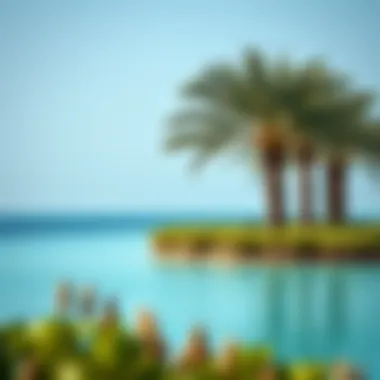
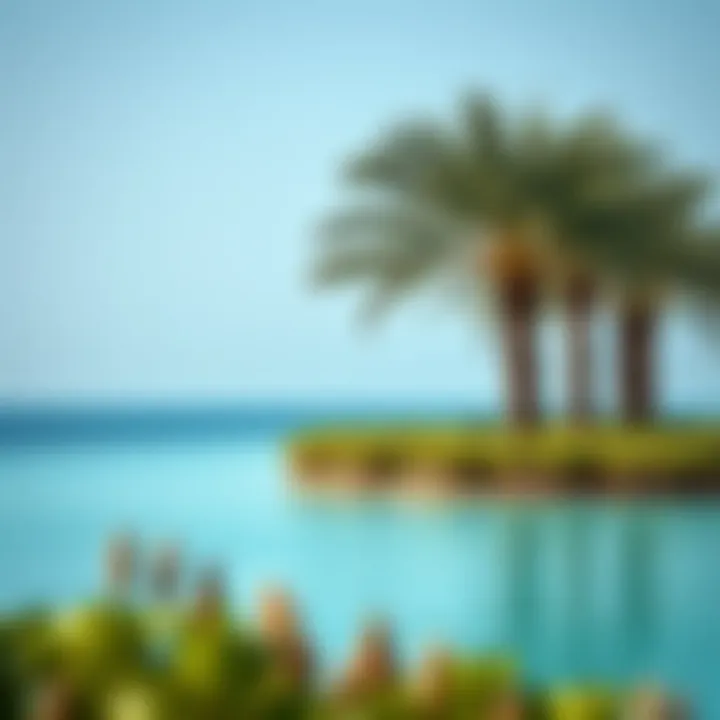
In summary, the challenges facing Palm development are multifaceted. However, with diligent planning and an openness to adaptation, these hurdles can be transformed into stepping stones towards a successful venture that truly enhances Ras Al Khaimah's living and economic landscape.
Future Prospects and Trends
The development of the Palm in Ras Al Khaimah represents a vital piece in the larger puzzle of the region's real estate landscape. Not only does it serve as a benchmark for future developments, but it also symbolizes the aspirations of the local economy to diversify and attract international investment. Understanding the trends that dictate the future of properties like the Palm is important for both stakeholders and potential investors. This section explores potential for expansion, innovative trends in real estate, and how these elements can shape the developmental approach moving forward.
Potential for Expansion and Development
The horizon for the Palm project suggests a multitude of opportunities for expansion. Given the strategic location of Ras Al Khaimah, which sits between the diplomatic and commercial hubs of Dubai and Abu Dhabi, further development seems almost inevitable.
- Strategic Location: The geographical advantages provide connections to international trade routes, facilitating easier access for commerce.
- Local Demand: There are indications of an increasing demand for luxury residential units, not just from expatriates but also from locals seeking an upscale lifestyle.
- Government Support: The support for real estate from local authorities indicates a willingness to attract and sustain growth in the sector.
In addition, urban planning initiatives are in place that further encourages development, allowing the area to grow in ways that align with both economic and community needs.
Emerging Trends in Real Estate Concepts
Developments like the Palm are not just about physical structures; they reflect evolving trends in real estate that prioritize sustainability, technology, and community integration.
- Sustainable Architecture: More projects are focusing on minimizing their environmental impact through green building techniques. The Palm aims to incorporate solar energy, efficient waste management systems, and eco-friendly materials in construction.
- Smart Technology: The integration of smart home technologies is transforming residential expectations, making homes more energy-efficient while providing enhanced living experiences. From automated lighting to advanced security systems, the smart home revolution is underway.
- Community-Centric Design: The trend towards designing spaces that promote community interaction is gaining traction. Projects that feature shared amenities—parks, pools, and recreational areas—encourage social engagement among residents, enhancing their connection to the community.
Real estate is not merely about the physical; it must adapt to societal and technological shifts to remain relevant.
As these trends gain momentum, it becomes clear that the Palm project is poised to set the stage for what future real estate endeavors in Ras Al Khaimah could look like. Investors, developers, and property managers alike must keep an eye on these trends to ensure they are not just participating but leading the conversation in real estate innovation.
Case Studies of Successful Developments
Examining real estate projects through detailed case studies can illuminate the path forward for developments like Palm Ras Al Khaimah. They offer a treasure trove of insights that go beyond mere statistics and figures. These analyses highlight the trials and triumphs of various developments, presenting a nuanced understanding of what has worked, what hasn’t, and the factors contributing to each outcome.
When we consider the Palm development in Ras Al Khaimah, looking at similar undertakings around the world helps clarify expectations and opportunities. It paints a picture of the dynamic nature of real estate initiatives, particularly in regions with unique geographical and cultural contexts.
Effective case studies are crucial as they:
- Show real-world impacts: These projects provide tangible evidence of potential economic benefits or failures, serving as a guide for future endeavors.
- Highlight innovative solutions: By analyzing both successes and failures, stakeholders can draw lessons from existing projects and potentially replicate successful strategies or modify approaches based on failures.
- Foster informed decision-making: For investors and developers, understanding previous projects helps in better risk assessment and can lead to informed investment decisions.
Comparative Analysis with Other Projects
Referring to successful developments in similar climates and cultural settings can shed light on the Palm project’s potential. Take, for instance, the man-made islands of The World in Dubai. While ambitious, it faced numerous challenges, from legal disputes to environmental concerns, which have impacted its long-term viability. In contrast, projects like the Yas Island in Abu Dhabi have thrived partly due to effective stakeholder collaboration and community integration.
Here are some of the points of comparison:
- Strategic Planning: How well a project anticipates future demand. For example, Yas Island incorporates diverse attractions that appeal to tourists and locals alike, which could be a critical learning for Palm Ras Al Khaimah.
- Sustainability: Utmost care for environmental impact. Developments like the eco-friendly materials used in The Sustainable City in Dubai highlight the necessity of green building practices – something that should be at the forefront of Palm Ras Al Khaimah’s development.
- Community Integration: The importance of integrating local culture and economy. The success of Abu Dhabi’s Al Maryah Island, with its focus on residential and commercial spaces for local populations, showcases how engaging the community can propel a project forward.
Lessons Learned and Applications
The insights gleaned from comparative case studies provide a rich foundation for the planning and execution of Palm Ras Al Khaimah. Consider the following lessons that can be applied:
- Collaboration is Key: Engaging with local stakeholders from the outset helps avoid pitfalls and allay community concerns. This was evident in the successful planning processes for developments like the Dubai Marina, where investor interests aligned closely with community needs.
- Adaptability: The ability to pivot based on market conditions or environmental feedback is crucial. The shifting approach of the Dubai Creek Harbour project, which readily adapted to unforeseen challenges, exemplifies this adaptability.
- Innovation in Design: Projects that incorporate unexpected design elements often stand out. The Eye of Dubai, a recent addition to the skyline, shows how innovative, visually appealing designs can become iconic landmarks, attracting tourism and investment.
By learning from the past, we can craft a more prosperous future.
Epilogue
In dissecting the numerous facets of the Palm project in Ras Al Khaimah, one acknowledges the broader implications of such a development, which is not merely confined to economic interests but extends into the realms of social structure, environmental stewardship, and cultural integration. The Palm project stands as a pivotal point within Ras Al Khaimah's real estate narrative, acting as a beacon for future investments and residential options.
Investors, property managers, and home buyers can glean several benefits from the insights shared throughout this article. Recognizing the synergy between economic growth and community involvement offers clarity in how to approach future land ventures.
Another significant consideration is the emphasis on sustainable practices, underscoring a commitment to environmentally friendly development. In light of global trends toward responsible real estate and resource conservation, this project sets a benchmark. The integration of smart infrastructure presents a thrilling glimpse into what the future may hold for residential solutions.
Summary of Insights and Reflections
Reflecting on the various elements discussed, it becomes evident that real estate development in Ras Al Khaimah is inextricably linked to its history and cultural fabric. The Palm's architectural design not only reflects modern trends but also pays homage to the traditional values of the region.
Furthermore, the project embraces technological evolution, showcasing how smart homes may redefine living standards in the UAE. The challenges highlighted – from market fluctuations to environmental concerns – are crucial in understanding the complexities surrounding this ambitious endeavor. Failures of other projects in comparable regions serve as valuable lessons, emphasizing the need for meticulous planning and risk assessment.
Final Thoughts on Palm Ras Al Khaimah’s Evolution
Palm Ras Al Khaimah is not merely a real estate project; it is a vital cog in the wheel of the region's evolution. Its success could serve as a catalyst for neighboring developments, steering the local economy towards sustainability while promoting tourism and lifestyle changes. Investors eyeing this opportunity should move forward with an open mind, ready to engage in a dialogue with local stakeholders and ensure that developments respect and integrate with Ras Al Khaimah's rich heritage.
This landscape is poised for transformation, and the Palm project embodies that transition. As the dust settles on initial phases, it will be interesting to observe how the project unfolds and what new partnerships and innovations may emerge from such a robust framework. For more information or deeper insights on land investment dynamics and real estate trends, resources such as Encyclopedia Britannica or regional government websites offer a wealth of information.
References and Further Readings
In the intricate dance of real estate development, knowledge serves as a compass for investors and stakeholders navigating the Palm project in Ras Al Khaimah. This section underscores the significance of references and further readings, shedding light on its essential role in shaping informed decision-making and strategic thinking. Understanding the nuances of development requires more than just surface-level comprehension; it mandates a deep dive into literature and resources that illuminate various facets of the industry.
The importance of this topic encompasses several key elements:
- Informed Decision-Making: Access to reliable literature allows investors to weigh risks and opportunities effectively. Knowledge is power, as they say, and that old adage holds true in the realms of property management and real estate investment.
- Benchmarking Best Practices: By examining case studies and industry reports, readers can gather insights on successful strategies employed in similar developments. This emulation of best practices can hasten progress and improve outcomes.
- Understanding Regulatory Frameworks: Real estate development often exists within a complex matrix of legalities and regulations. Accessible resources shed light on the planning frameworks, zoning laws, and environmental considerations crucial for assessment.
- Broader Economic Trends: Various resources can elucidate how larger economic shifts impact local markets. This grasp of economic principles not only informs present strategies but helps in predicting future trends.
By diving into robust literature and reputable online platforms, stakeholders can enrich their understanding, fostering a framework for informed participation in the Palm project. Here's a deeper insight into some suggested readings and resources that can bolster knowledge around real estate development.
Recommended Literature on Real Estate Development
A wealth of literature has been produced around real estate development that elucidates its complexities, challenges, and opportunities. Notable works include:
- "Real Estate Development: Principles and Process" by Travis P. H. W. – This text breaks down the development process from conception to final product, providing insights that are particularly relevant to initiatives such as the Palm project.
- "The Real Estate Wholesaling Bible" by Than Merrill – Though focused on wholesaling, Merrill’s book offers perspective on the real estate market dynamics that can be incredibly beneficial for potential investors.
- "Governing the Commons: The Evolution of Institutions for Collective Action" by Elinor Ostrom – For those interested in the intersection of community and development, this book provides critical insights into resource management and stakeholder engagement.
Additionally, scholarly articles in journals like the Journal of Real Estate Research can provide recent studies on emerging trends and methodologies within development.
Relevant Online Resources
In today’s digital landscape, a plethora of online resources are available to anyone diving into the world of real estate. These platforms not only deliver current information but also facilitate networking and engagement with industry professionals:
- Encyclopedia Britannica: An excellent source for foundational knowledge about real estate principles and key terminologies. Link to Britannica
- Wikipedia: Provides a broad overview of various real estate developments and notable projects worldwide, offering a great starting point for further exploration. Link to Wikipedia
- LinkedIn: A powerful platform for connecting with industry experts and gaining insights into market trends. Join relevant groups focused on real estate development and local market trends. Link to LinkedIn
- Government Publications: Many regional planning departments offer documents outlining zoning regulations and development guidelines. Look for .gov resources specific to the Ras Al Khaimah region.
Utilizing these resources can cultivate an in-depth understanding of the real estate landscape in Ras Al Khaimah, empowering stakeholders to engage critically with the Palm project. Just remember, in such a rapidly evolving field, continuous learning is key to staying ahead.















